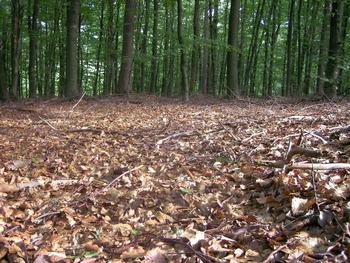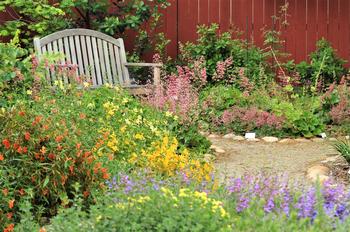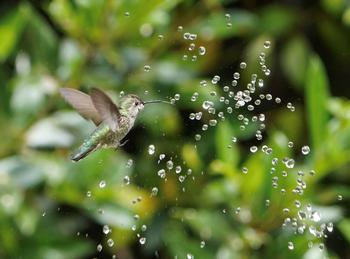Can a sustainable garden be beautiful?
-
Marie Narlock
-
Sustainable landscaping essentially comes down to four tenets. 1) Treat your soil like gold. 2) Grow native and other low-water plants. 3) Conserve water. 4) Avoid chemical warfare. Do these, and your garden will hum with life, help mitigate climate change, and protect our biodiversity.
But here’s the real question: how do you make it look good? In other words, can a sustainable garden be attractive?
The answer is YES. Regardless of your taste – elegant, eclectic, easygoing, exotic – there’s an intersection where design and sustainability meet.
Soil: beauty starts underground
Soil is like a sleeping underground giant: keep him fed and warm and he’ll happily push up flowers. Thankfully he only needs two ingredients: compost and mulch. Using compost & mulch in the garden replicates the forest, where organic material slowly decomposes to feed the soil. Photo: Creative Commons
Using compost & mulch in the garden replicates the forest, where organic material slowly decomposes to feed the soil. Photo: Creative CommonsPicture the forest floor. Tree leaves and twigs drop continuously, creating a cushy layer of mulch. This organic material decomposes, feeds the soil, and ultimately provides the nutrients surrounding plants need. This process continues nonstop 24-7.
To replicate this, apply a thin layer of compost around plants annually and top it with a layer of mulch. Skip this step and your giant might get cranky and stop giving you flowers.
There are many types of mulch, so let your aesthetic and pocketbook be your guide. Cost is lower by the yard than in bags. Lucky you if you have a teenager to help spread it.
One cautionary note: be careful of dyed mulch, which may contain undesirable chemicals. And black mulch may become dangerously hot in summer heat. Composted wood chips are the least combustible, an important consideration.
Plants: what the well-dressed garden is wearing
Native plants are the cornerstone of a sustainable garden. They’re naturally adapted to our soil and climate, they attract beneficial insects that co-evolved with them, and they keep our biodiversity healthy and abundant. Start with natives and then select other low-water choices that lure bees, butterflies, and hummingbirds. California native penstemon, monkey flower, coral bells & coffeeberry are easy, low-water, and invite pollinators into the garden. Photo: Jeff Silva
California native penstemon, monkey flower, coral bells & coffeeberry are easy, low-water, and invite pollinators into the garden. Photo: Jeff SilvaMother Nature happens to be a great planting design teacher, artfully placing plants in repeated drifts of varying foliage textures and colors. There’s much to learn from her, but you may have an easier time thinking of your closet instead.
Combining plants is like getting dressed: pairing a burgundy sweater with gray slacks works, but you’d look like a clown if you wore plaid pants with a striped top.
Same goes for plants. Say yes to chartreuse and burgundy, dark green and light green, icy blue next to white. Say no to continuous swaths of the same green. Focus on leaves, not flowers. Go for maximum contrast: huge leaves next to grass blades, an upright grower next to a mounding form. When you find a combo you like, repeat it. It will make your garden look and feel cohesive.
Visit the plant section on the Marin Master Gardener website to learn more.
Water: be strategic
Although it rained like mad this year, drought will return. You can count on it. If you still have a lawn, please replace it with something else (except a fake lawn). A small fountain or shallow dish of water pleases wildlife and is a beautiful addition to the Earth-friendly garden. Photo: Steph McBlack
A small fountain or shallow dish of water pleases wildlife and is a beautiful addition to the Earth-friendly garden. Photo: Steph McBlackInvest in a drip system. If you’re not the DIY type, get referrals at nurseries, irrigation stores, or your local water company. Generally speaking, water deeply and infrequently. Choose permeable surfaces (gravel, mulch, pavers set in sand) for paths and patios to allow rainwater to sink underground and help recharge our groundwater.
How about the fun side of water, a beautiful component of a sustainable garden? Adding a shallow dish invites bees and butterflies to take a sip. A small fountain lures birds. Ever watched a hummingbird bathe? It’s pretty magical.
Chemicals: just say no
Here’s an easy one. Don’t use pesticides or synthetic fertilizers, which can have unintended consequences for soil, water, and wildlife. Last thing you want to do is force feed poison to your sleeping giant or kill off the very insects you invited into the garden.
Nah, that’s not you. Besides, you’re too busy lounging in your fabulous Earth-friendly garden.



